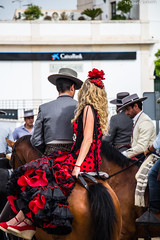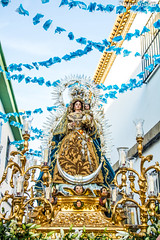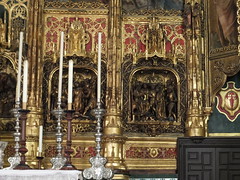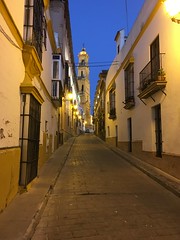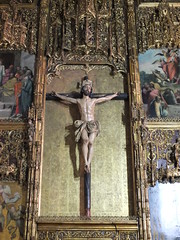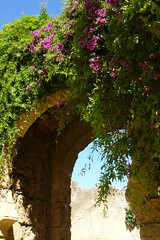Marchena
Marchena is a town in the Province of Seville in Andalusia, Spain. From ancient times to the present, Marchena has come under the rule of various powers. Marchena is a service center for its surrounding agricultural lands of olive orchards and fields of cereal crops. It is also a center for the processing of olives and other primary products. Marchena is a town of historic and cultural heritage. Attractions include the Church of San Juan Bautista within the Moorish town walls and the Arco de la Rosa (Arch of the Rose). The town is associated with the folkloric tradition of Flamenco. It is the birthplace of artists including Pepe Marchena and Melchor de Marchena, guitarist.
Etymology
The town's Moorish name was Marshēnah (مَرْشَانَة) which means "of the olive trees".
Location
Marchena is located in the south of Spain, east of Seville. To the north are the hills of the Sierra de Horncheulos Nature Park. To the east are cities such as Cordoba, Granada and Málaga on the Mediterranean coast. To the south is Gibraltar.
Geography
Marchena lies on a plain in the Guadalquivir Valley at an elevation of . The climate is described as "Mediterranean Continental" with cold winters, hot summers and moderate rain. Summer temperatures can be over 40 degrees Celsius. Water comes from branches of the Corbones River such as the Arroyo del Lavadero stream.
The area of the town is and in 2006, its population was approximately 19,773. Marchena is a centre for primary industries such as olive, cotton and wheat farming and secondary industries such as canning and greenhousing. These industries are supported by public amenities including schools and sports centres. Marchena's historical area is located in the northern part of the town. Urban development has occurred in the western (San Miguel neighborhood), southern (Santo Domingo, San Sebastián) and southeastern (San Andrés) parts of town. The railway delimits the northern part of the town.
History
Early inhabitants
Human habitation of the Marchena area dates to prehistoric times at the third millennium BCE.
In the eighth to seventh century BCE, a Phoenician community lived at Montemolin near Marchena.
From the first millennium BCE, the Tartessian civilization gathered metals such as tin and gold from the waters of the Guadalquivir River and brought their culture to the area of Marchena. This may have included centres of ceremony and ritual.
Roman era
Around the 6th century BCE, the Carthaginians occupied Seville. Products of the area were transported to Carthage. In the late 3rd century BCE, forces of the Roman Empire under Publius Cornelius Scipio reached Seville. The region flourished under Roman rule for centuries. However, records of the time do not clearly identify the archaeological ruins about Marchena. Local authorities suggest they may include Castra Gemina, Cilpe and Colonia Marcia. Marchena fell into the Roman province of Hispania Ulterior and within that, in Hispania Baetica and within that, Hispalis (Seville).
Germanic tribes
As the Roman Empire declined, in the early 5th century CE the Vandals (a Germanic people), the Alans (an Iranian nomadic people of the North Caucasus), and the Suebi (another Germanic tribe) entered Spain from the north. In their division of Spain, Hispania Baetica fell to the Vandals. The Visigoths also invaded Spain from the north. They ruled Baetica from 497 CE to 711 CE. However, in comparison to the flourishing economy under Roman rule, under the Visigoths, the population decreased, agricultural endeavours were abandoned and once trading towns became small forts. Evidence for this change comes from the archaeological surveys of the kilns used for manufacturing amphora, and of olive presses and basins.
Muslim era
From 711 CE, in its weak state, the Visigoth Kingdom gave way to Muslim invaders from North Africa. In July 712 CE, Musa bin Nusayr, the provincial governor of northwest Africa, brought 18,000 men across the Strait of Gibraltar, paused at the fortress of Carmona, approximately northwest of Marchena, and then took Seville. Iberia became part of the greater Umayyad Caliphate under Abd al-Rahman I (731 CE 788 CE).
At the time of Muslim rule, Marchena was called Marsenah or "Marshana". Despite infighting between Arab clans and their associated Barber supporters, resident Arabic speaking Christians and Jews, Muslim Spain flourished. For example, Banu Jahwar Al-Marshaniyyun of the Hawwara clan lived in Marchena and was very wealthy. By the 12th century, Marchena was a medina (township) with a strong fortress and well defined systems of governance. It was part of the Almohad Caliphate until 1247 when the Christian forces of Ferdinand III of Castile (1199 CE 1252 CE) took Marchena before laying Siege to Seville. Some Muslims were allowed to keep their homes and possessions while others, including some poets and writers, were forced to emigrate.
Christians
Until his death in 1309, Alonso Pérez de Guzmán (1256 1309) was the local ruler of Marchena. On 18 December 1309, Ferdinand IV of Castile (1285 1312) made Fernando Ponce de Leon the new local ruler of Marchena. He was the great-grandson of the king, Alfonso IX of León. Fernando's son, Pedro Ponce de León the Elder (died 1352) became the next Lord of Marchena. Pedro's son, Juan was the Lord of Marchena till his death by execution in Seville in 1367. Juan's brother then inherited the position but died in 1387.
In 1482, Queen Isabella I of Castile created the title of "Duke of Arcos" which was bestowed on Rodrigo Ponce de León, Duke of Cadiz (1443 1492). Rodrigo was the seventh Lord of Marchena.
Ponce de Leon family
In the late part of the 15th century and the early part of the 16th century, southern Spain was afflicted with epidemics of plague. Nonetheless, Marchena remained a prosperous town from the 15th to the 18th centuries due to the patronage of the Ponce de Leon family and their descendants.
Peninsular war
Between 1807 and 1814, Spain was consumed in the Peninsular War, part of the Napoleonic wars. In 1808, the first volunteer infantry regiment of Marchena was raised. In 1809, Brigadier General John Downie in command of the Royal Extremadura Legion liberated Marchena from the French.
19th century
In the 19th century, Marchena as part of Andalusia, went through an era of poverty. This was due to the loss of trade of produce with Spain's colonial lands; the giving of land to war heroes; and political unrest. In 1857, the population of Marchena was 13,005. Workers from agrarian centres like Marchena, moved to industrialised areas.
20th century
On the background of the weak military dictatorship of Miguel Primo de Rivera (1870 1930) the Spanish Constitution of 1931 was ratified. However, Seville province became a focus of communist and anarchist activity. In Marchena, the premises of the town's branch of the Confederación Nacional del Trabajo (National Confederation of Labour) were paid for by local landowners. The CNT worked to organise the various trade unions. Local labour arbitrators accepted the CNT conditions for maintaining working conditions and protecting day labourers. One of the leaders of the socialist movement in the region was Mariano Moreno Mateo (a lawyer and forensic psychiatrist) of Marchena. In the general elections of 1931, the socialist, republican and leftist parties defeated the monarchist and right wing parties.
From 1936, Francisco Franco (1892 1975) led the ''Bando nacional'' through the Spanish civil war to become dictator until his death. Franco made Seville his first base of operations. Suspected opponents in the area, including those in Marchena, were rousted and killed.
Historic buildings
Marchena is a tourism site due to its historical and cultural heritage.
Church of San Juan Bautista
The Church of San Juan Bautista of Marchena on Calle Cristobal de Morales is a gothic mudejar style religious monument of the late 15th century that venerates John the Baptist. The church has a number of seignoral entrances. One uses brick and another is decorated in wood ornaments showing evangelical scenes in relief, paintings of Alejo Fernandez (circa 1475 1545), a marble bust of John the Baptist and the shields of Diego Deza (1444 1523) the Grand Inquisitor.
The Epistle organ (on the left when facing the choir) was built by Francisco Rodríguez a pupil of Jordi Bosch i Bernat. It was made in 1802. In the 17th century the Baroque choir was carved in cedar wood by Juan Valencia on designs by Jerónimo Balbás. Within, there are also sculptures by Alonzo Cano (1601 1667). Ornaments in gold were made by Francisco Alfaro.
In the sacristy are nine paintings, created for the church by Francisco de Zurbarán (15981664) which were installed in 1637. In 1688, Pedro de Mena (1628 1688) sculpted a portrayal of the Immaculate conception for the church.
The church is also the parochial museum, open by appointment.
Santa María de la Mota Church
The Santa María de la Mota Church was built in the sixteenth century in the grounds of the ducal palace. It was built in the Gothic - Mudejar style on the site of a previous mosque. It has two types of façade, one in brick and another in ashlar. The tower is in the Renaissance style. The church has three naves, separated by a quadrangle of pillars. The apse has a rectangular and an octagonal section. The decoration of the church is a mixture of Christian and Islamic features. Over the altar is the image of the Virgen de la Mota, carved in the 16th century. In the time of the Rodrigo Ponce de León, 4th Duke of Arcos (1602 1658) a cloakroom, a prayer room and a passageway to the duke's residence were added. The chapel master was the composer Cristóbal de Morales (c. 1500 1553). In 1539, the organ was repaired. The Convent of the Immaculate Conception is located at the same site. The convent was founded by the Dukes of Arcos. Marchena's community of Poor Clare nuns make sweets such as pestiños borrachuelos.
San Agustín Church
The Iglesia de San Agustin was built in the second half…
Looking for places related to Marchena?
Those are other destinations to find places related to Marchena:



